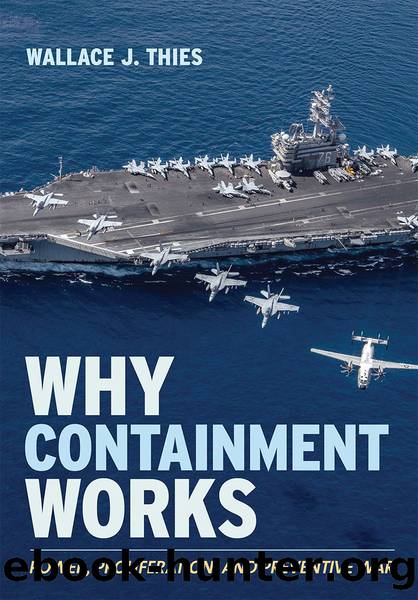Why Containment Works: Power, Proliferation, and Preventive War by Wallace J Thies

Author:Wallace J Thies [Thies, Wallace J]
Language: eng
Format: epub
Tags: United States, Military, Political Science, Wars & Conflicts (Other), History, Security (National & International)
ISBN: 9781501749483
Google: 6XW4DwAAQBAJ
Goodreads: 48817469
Publisher: Cornell University Press
Published: 2020-11-15T00:00:00+00:00
Fighting the Last War
Saddam Husseinâs Iraq had numerous military assets and advantages at its beckoning, including a very large army made up of more than one million soldiers, dozens of divisions, and thousands of tanks, artillery pieces, and armored personnel carriers. Second, Saddam Hussein had at his disposal Iraqâs enormous oil wealth, which could have done a lot to strengthen Iraqâs armed forces and its civilian economy, provided the money was spent judiciously and not squandered on items that were beyond the Iraqi armed forcesâ capabilities. Third, Iraq was seven thousand miles from the United States, which suggested that Saddam had some room for maneuver, provided that he was careful about whom he provoked and for what reasons. Fourth and finally, Iraqâs location meant a considerable asymmetry between the burdens that another Middle East war would place on Iraqi and US forces. US forces would have to fly seven thousand miles to reach Iraq; the Iraqis had only to drive across a desolate frontier to reach Saudi Arabia. The Americans had many interests that made repeated demands on the first Bush administrationâs full attention. Small states like Kuwait might occasionally topple off the Bush administrationâs radar screen. How much longer could the Americans be trusted to keep Iraq contained, at a reasonable cost? Would the Americans grow weary of protecting the gulf region again? American commentators and pundits were often in awe of Saddamâs million-man, tank-heavy army, and the Iraqi Army did indeed look formidable on paper or at the parade ground. Even so, we can see now that there were indeed multiple reasons why Iraqi assets and advantages proved not to be worth much at all.
First, Saddam was seriously overconfident. Saddam wanted to fight the first Gulf War, and to fight it much the same way he had fought the Iranians, only this time against the United States and Britain. Saddam had not accumulated all those tanks and artillery pieces and the soldiers needed to run them by accident or inattention. Saddam instead wanted all those weapons to fill two roles: first, to allow Iraq to intimidate, or even invade, neighboring states; and second, to stop another stateâs counterattacks before they could penetrate too deeply into Iraq itself. Iraqâs army may have been a good one (by Middle East standards), but the coalitionâs forces were much better. Much of Saddamâs army consisted of poorly trained conscripts whose idea of a fortified position was a three-foot-high wall of loose gravel, which accomplished little other than providing the Americans with aim points. Conversely, most of the coalitionâs soldiers were long-term professionals, who expected to be sent on expeditionary campaigns rather than huddle in bunkers and wonder when the Americans would arrive.
Second, not even Saddam himself could hold together indefinitely a million-man army made up largely of teenage conscripts. How could Saddam hope to fight the Americans and still survive? One possibility here would be to resurrect what Saddam believed to be an Iraqi military triumph, and then fight it all over again.
Download
This site does not store any files on its server. We only index and link to content provided by other sites. Please contact the content providers to delete copyright contents if any and email us, we'll remove relevant links or contents immediately.
| Bahrain | Egypt |
| Iran | Iraq |
| Israel & Palestine | Jordan |
| Kuwait | Lebanon |
| Oman | Qatar |
| Saudi Arabia | Syria |
| Turkey | United Arab Emirates |
| Yemen |
Empire of the Sikhs by Patwant Singh(22974)
The Wind in My Hair by Masih Alinejad(5034)
Rise and Kill First by Ronen Bergman(4704)
The Templars by Dan Jones(4628)
The Rape of Nanking by Iris Chang(4138)
12 Strong by Doug Stanton(3508)
Blood and Sand by Alex Von Tunzelmann(3138)
Babylon's Ark by Lawrence Anthony(2620)
The History of Jihad: From Muhammad to ISIS by Spencer Robert(2572)
No Room for Small Dreams by Shimon Peres(2320)
The Turkish Psychedelic Explosion by Daniel Spicer(2314)
Inside the Middle East by Avi Melamed(2305)
Gideon's Spies: The Secret History of the Mossad by Gordon Thomas(2304)
Arabs by Eugene Rogan(2262)
The First Muslim The Story of Muhammad by Lesley Hazleton(2219)
Come, Tell Me How You Live by Mallowan Agatha Christie(2212)
Bus on Jaffa Road by Mike Kelly(2102)
Kabul 1841-42: Battle Story by Edmund Yorke(1986)
1453 by Roger Crowley(1964)
